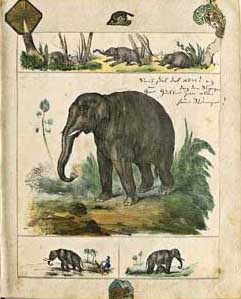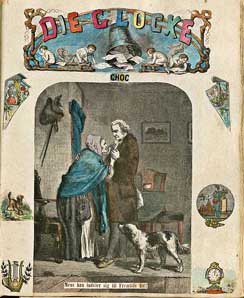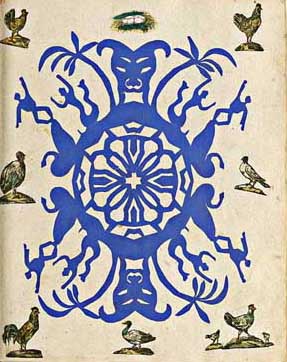|
Introduction by Erik Dal
What sort of a book is this?
Christine抯 Picture Book is a beautifully bound scrapbook of 122 leaves, slightly larger than A4 format, dating from 1859. On the right-hand pages and some of the left-hand ones, more than 1,000 pictures of widely varying kinds have been pasted in, most of them printed in colour or hand-coloured. In many instances, amusing little hand-written captions or verses have been added.
Who made it?
It was compiled by Hans Christian Andersen and his friend, a Danish magistrate named Adolph Drewsen, who is named on the first sheet as being Christine抯 grandfather. The occasion was her third birthday, 30 October 1859.
Who was Christine, and where is the scrapbook now?
She was the great-grandchild of Jonas Collin, a civil servant who had been of great support to the young Hans Christian Andersen, and to whose family Andersen became closely attached. In 1826, Collin抯 daughter, Ingeborg Collin, married Adolph Drewsen (1809�), and in 1850 their daughter Jonna married Baron Henrik Stampe. They had six children, including Baroness Christine Stampe (1856�). One of her grandsons married Countess Alette Bardenfleth (1925�), lady-in-waiting to the Queen. In 1983 Countess Bardenfleth decided to publish the book and set up a foundation, Christine Stampes Billedbog, whose funds for a number of years were to support projects connected with Danish history, language, literature and music. The scrapbook itself was to be donated to Silkeborg Kunstmuseum, because the Drewsen family and the history of Silkeborg are closely linked. Danish, German, English and Italian editions of the book were published in 1984 and a Swedish edition in 1985.
What sort of pictures does the book contain?
Virtually, anything and everything: scenes of nature, both domestic and foreign, all kinds of domestic and wild animals in (or often outside) their natural surroundings, people from all periods, all strata of society and engaged in all kinds of occupations, also as individual figures in the most diverse situations, and also all manner of decorative objects and articles of everyday use, or purely decorative details. A number of them are portraits that have been signed � others are probably portraits whose names are missing or have been cut off. Very often pictures have been combined to create a situation, or simply for decorative purposes � perhaps rather too many little figures have been used as ornamentation around important or larger pictures. Many of the pictures are illustrations, including pictures of scenes from plays, but as a rule without naming either the theatre or the play in question, which would not be of much interest to a child.

Plate 14
Where did the pictures come from?
Briefly and broadly, from three countries: Denmark, Germany and France, but also (at least once, Plate 88) from England. But from which publications?
Very important in this connection are the quantities of illustrated picture-sheets of widely varying quality. From 1833�, a periodical known as a 憄enny magazine� was published in Denmark, Germany and England with varied contents including short stories, articles and satirical pieces, and the same applied to the almanacs of the times, which to an increasing extent were furnished with the same sort of material in addition to their purely calendrical information, and more or less well-produced magazines followed suit. One of subjects of interest was travelling, spurred by the explorers and expeditions of the period and especially by the enormously increased opportunities of visiting other places and countries provided by railways. As is well known, Hans Christian Andersen took advantage of these possibilities more than many other people. His travels throughout most of Europe and also to parts of Asia and Africa took up almost nine years of his adult life and bore fruit in the form of several full-length books and articles and also in many fairy tales and novels.
Newspapers hardly come into the picture. A close examination of Danish newspapers from September and October 1859 revealed little more than heraldic motifs in advertisements inserted by foreign insurance companies.
Books as sources for Christine抯 Picture Book is a ticklish question, for few people care to split up a book just for the sake of a couple of pictures. However, illustrated publications for children had existed from about 1800, first visual instruction pictures and books about geography and natural history, but around 1850 also imaginative writings and genuine folk tales, possibly books with a little poem and an illustration on every page, as in H.V. Kaalund抯 and J. T. Lundbye抯 Fabler for B鴕n (Fables for Children) (1845) or Den store Bastian (1847), which was a Danish translation of the German Der Struwwelpeter, featuring terrible punishments for disobedient children. And Hans Christian Andersen抯 fairy tales were published with the Danish artist Vilhelm Pedersen抯 illustrations from 1848, actually later than illustrated editions in several other countries.
Far more important in this connection are the popular picture-sheets of the period, which covered many subjects. Many of them were bits of scenery for puppet theatres, perhaps characters to set up on a little foot, but many were full sheets, not so suitable for Andersen抯 and Drewsen抯 purposes. But they were produced in enormous quantities, and they could be bought from both street vendors and 憄roper� bookshops and stationers.
It was just at this time, in the middle of the nineteenth century, that many alternative printing techniques were developing. Colour printing existed, but the colouring of popular illustrations was usually done by hand, often by professional, skilful children. A number of Christine抯 pictures were coloured by the album抯 two compilers.
What was the purpose of the books?
Yes, books in the plural, because Christine Stampe was the youngest of three sisters, and Grandfather Drewsen and his friend Hans Christian Andersen made a picture book for each of them.
Rigmor抯 is from 1852 and is now in Norwegian ownership. Astrid抯 is from 1853, when she was only one year old � it returned to its original home when Peter Stampe-Holst, owner of Nys�, the family estate near Pr鎠t�, acquired it in 1958 at one of the largest auctions of the period. Today it belongs to Odense City Museums.
Apart from the work on the pictures, both Drewsen and Andersen also contributed texts. It is easy to see whether the handwriting is Andersen抯 � large and rather sprawling � or Drewsen抯, which is smaller and neater (see for example Plates 99 and 98). Whether Andersen may have composed some of the verses penned in Drewsen抯 hand is hard to say. However, it must be assumed that the work as a whole was predominantly done by Grandfather Drewsen, who in a letter to his poet friend in 1857 mentioned his growing delight in seeing pictures and making picture books for the little ones.
Common to all three scrapbooks is their total disorder, which has even led to the separation of large coherent sheets (see, for example, Plates 34 and 107). The aim has been to amuse rather than provide useful information. And in some places quite unchildish attitudes are revealed, such as 憈he participants� in the royal menu (Plate 105) and, worse, the treatment of a deeply serious historical scene (Plate 81) must have been by mutual consent � and intended for grown-ups.

Plate 81
The two men no doubt shared a sympathetic understanding. They could express themselves critically about one another � the one man抯 legalistic hair-splitting and the other抯 self-centredness and hysterical anxieties. But they had something important in common: neither of them were Collins! Though one of them had found a splendid wife and the other a home in this highly respected family.

Plate 11
What about the silhouettes?
There are only a few, but they are important. Plate 11 has a whole collection of Andersen抯 favourite figures: mermaids and swans. Plate 18 has a troll, rather unnecessarily guarded by four soldiers. Plate 59 has perhaps the most distinguished of many silhouettes of dancers, though unfortunately also burdened with various decorations. Plate 80 has a light and delicate landscape and again two of Andersen抯 favourites, the swan and the stork. And finally, Plate 91 shows dancers, meant to be folded so that they could be stood up. Andersen cut many silhouettes, often for the entertainment of others and perhaps accompanied by a little story about what kind of picture was coming now. On the other hand this scrapbook contains none of the drawings which Andersen also made, about 300 of which are known; until about 1830 they were of various imaginary beings, later only of buildings and districts. It was in his paper-cuts that he gave his imagination free rein.
For further information about Christine's Picture Book see Christine's Picture Book. Hans Christian Andersen and Grandfather Drewsen, with Footnotes and Postscript by Erik Dal, Kingfisher Books, London 1984.
Translated by David Hohnen
To the Picture Book
Top
|

